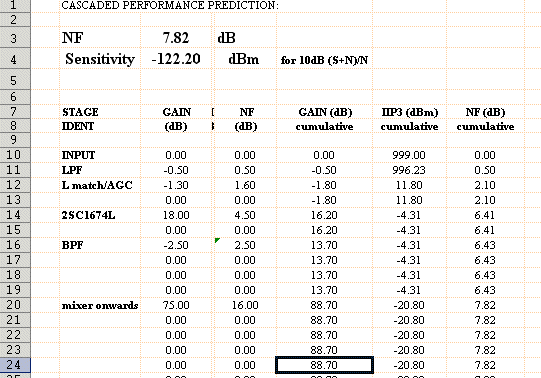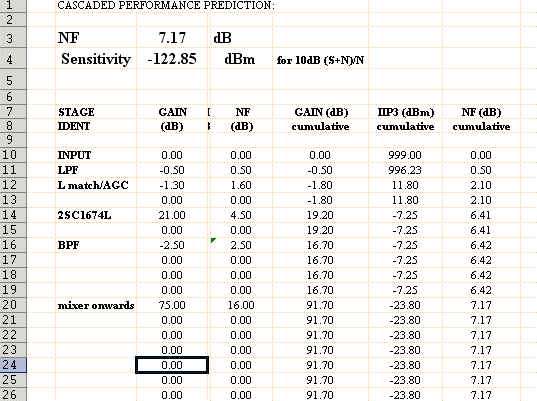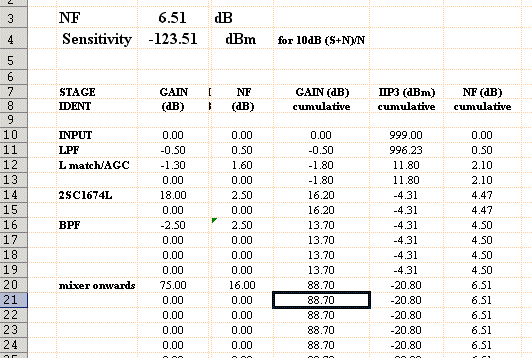Hi George
I saw a few of your old posts on TM1 and it seems a shame you were banned?
Note to Robb: My (UK) callsign G0HZU dates to around 1987. I initially passed the RAE at college in the early 1980s as a spotty student and got the G0 call a few years later.
Getting back to the front end of an early Uniden CB, this radio can be characterised the same way as any radio design regardless of cost.
As I said earlier, the receiver sensitivity can be modelled and predicted fairly well using a simple excel spreadsheet.
These days with the internet you are all spoilt laugh
laugh because of the ease of access to RF design tools
because of the ease of access to RF design tools  You can download these in a few mouse clicks.
You can download these in a few mouse clicks.
The tool to use in this case is a cascaded gain/noise calculator.
There's a very basic one here:
Online Calculator .:. Cascaded Noise Figure
You simply enter the gains and losses and noise figure of each stage of the receiver front end and it tells you the system noise figure.
These tools are very useful because the more versatile versions can easily show what changes are fruitful and which will be of little use.
The one I use is very old and it isn't mine to distribute but it has proved a faithful companion.
Here is an image of a very basic spreadsheet for the Cobra 148GTL-DX front end.

The key things to note are that there are about 2dB of passive loss before the 2SC1674L amplifier. Maybe a couple of dB after it.
Most noteworthy of all is the high noise figure from the mixer stage onwards.
This is typically about 16dB on a mk2 148GTL-DX but I think this can vary depending on mixer LO level etc.
But you can see that there is only about 13.5dB cumulative gain ahead of this mixer on line 19. This agrees with the network analyser plots shown earlier. This means that attempts to swap in a 'super low noise amp' for the 2SC1674L will bring very little reward in terms of added sensitivity.
There is no magic bullet here because the transistor already has a LOT of gain and trying for more gain will mean the risk of instability.
Realistically, any drop in replacement for the 2SC1674L isn't going to be any more than about 1dB quieter.
Even if it's 1dB quieter you don't get 1dB more sensitivity. The spreadsheet tells us that. The reason is because of the noisy mixer after the amplifier.
Putting the RF amp gain UP by 3dB doesn't seem to achieve much....

Reducing its NF by 2dB didn't make it 2dB better either...?

If you managed to find a transistor with 3dB more gain and 2dB lower NF than the current 2SC1674L then the NF drops from 7.8 to 5.6dB. But I don't think this is achievable.
You can see that later Uniden radios switched to a common emitter RF amplifier and FET mixer in an attempt to break away from this design dilemma. They also had to make the circuit work over a much wider bandwidth as well as being more sensitive.
Eg a Uniden 2830 measures out to be over 2dB more sensitive. They achieved this 2dB improvement through redesign rather than just swapping one transistor
I saw a few of your old posts on TM1 and it seems a shame you were banned?
Note to Robb: My (UK) callsign G0HZU dates to around 1987. I initially passed the RAE at college in the early 1980s as a spotty student and got the G0 call a few years later.
Getting back to the front end of an early Uniden CB, this radio can be characterised the same way as any radio design regardless of cost.
As I said earlier, the receiver sensitivity can be modelled and predicted fairly well using a simple excel spreadsheet.
These days with the internet you are all spoilt
The tool to use in this case is a cascaded gain/noise calculator.
There's a very basic one here:
Online Calculator .:. Cascaded Noise Figure
You simply enter the gains and losses and noise figure of each stage of the receiver front end and it tells you the system noise figure.
These tools are very useful because the more versatile versions can easily show what changes are fruitful and which will be of little use.
The one I use is very old and it isn't mine to distribute but it has proved a faithful companion.
Here is an image of a very basic spreadsheet for the Cobra 148GTL-DX front end.

The key things to note are that there are about 2dB of passive loss before the 2SC1674L amplifier. Maybe a couple of dB after it.
Most noteworthy of all is the high noise figure from the mixer stage onwards.
This is typically about 16dB on a mk2 148GTL-DX but I think this can vary depending on mixer LO level etc.
But you can see that there is only about 13.5dB cumulative gain ahead of this mixer on line 19. This agrees with the network analyser plots shown earlier. This means that attempts to swap in a 'super low noise amp' for the 2SC1674L will bring very little reward in terms of added sensitivity.
There is no magic bullet here because the transistor already has a LOT of gain and trying for more gain will mean the risk of instability.
Realistically, any drop in replacement for the 2SC1674L isn't going to be any more than about 1dB quieter.
Even if it's 1dB quieter you don't get 1dB more sensitivity. The spreadsheet tells us that. The reason is because of the noisy mixer after the amplifier.
Putting the RF amp gain UP by 3dB doesn't seem to achieve much....

Reducing its NF by 2dB didn't make it 2dB better either...?

If you managed to find a transistor with 3dB more gain and 2dB lower NF than the current 2SC1674L then the NF drops from 7.8 to 5.6dB. But I don't think this is achievable.
You can see that later Uniden radios switched to a common emitter RF amplifier and FET mixer in an attempt to break away from this design dilemma. They also had to make the circuit work over a much wider bandwidth as well as being more sensitive.
Eg a Uniden 2830 measures out to be over 2dB more sensitive. They achieved this 2dB improvement through redesign rather than just swapping one transistor
Last edited:



